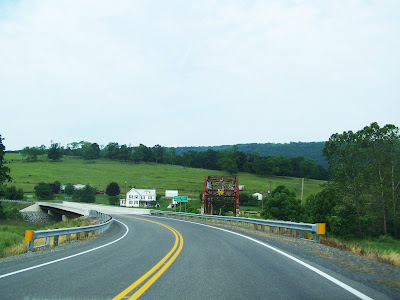We have wanted to visit the museum in Philippi again ever since our hurried stop in the town last year. We were delighted that the museum was open; the attendee proved to be not only knowledgeable but a very good storyteller. Here are some of the things we learned about Philippi from Olivia Sue Lambert (called Susie):

Susie Lambert graciously agreed to pose for a photo with me insude the museum. It was strange to think that in 1985, the museum was under water up to the roof eaves in the great flood that hit that state in the wake of Hurricane Juan.

 As we talked, a train whistle sounded and we ran outside to watch the train pass. I was amazed at how close to the building it passed--probably no further away that six feet or less. I watched it through a window inside and it was impressive to see the cars so close-up--yet separated by a mere piece of glass from where I was standing.
As we talked, a train whistle sounded and we ran outside to watch the train pass. I was amazed at how close to the building it passed--probably no further away that six feet or less. I watched it through a window inside and it was impressive to see the cars so close-up--yet separated by a mere piece of glass from where I was standing.
This drum was at the surrender at Appomattox and was brought back to Philippi by a soldier. During the terrible flood of 1985 the drum floated to the top of a shelf--where it yet remains.
 The extent of the flooding can be seen in photos at the museum. (A book called Killing Waters details the flood in Pocahontas County.)
The extent of the flooding can be seen in photos at the museum. (A book called Killing Waters details the flood in Pocahontas County.) The Philippi Covered Bridge , designed by Lemuel Chenoweth in 1852. still carries traffic into the downtown area. In 1989 the structure was severely damaged by fire, as you can see in the photos below:
The Philippi Covered Bridge , designed by Lemuel Chenoweth in 1852. still carries traffic into the downtown area. In 1989 the structure was severely damaged by fire, as you can see in the photos below:

 Inside the covered bridge. A very cool place.
Inside the covered bridge. A very cool place. - Philippi was the site, so state historians say, of the first land battle of the Civil War. According to Mrs. Lambert, an irate mother fired off the first shot, and the federal and Confederate troops each thought the other was firing and the battle was on.
- James Edward Hanger was injured in the battle and his leg was amputated. He returned to Virginia and developed a company that made prosthetic legs. The company is the largest maker of prosthetcis today--the Hanger Orthopedic Group, Inc.
- The main purpose of the battle was the railroads--thus making this the first battle to ever be fought over control of the railroads. The skirmish came to be called the Philippi Races because of the way the Confederates ran away from the scene.
- Lurch of Addams Family fame, was raised in Philippi.
We left regretfully, wanting to spend more time exploring the museum. Oh, the mummies? Yes, we saw them. I can't post photos, however, unless I speak with someone in Charleston because of some bad press the museum received from the media.
I can see both sides of the issue. But the mummies are there, they are eerie and beyond anything I expected to view in my lifetime. Just another strange twist in the history of a pretty little mountain town called Philippi.















 Good night.
Good night. ...which looks for all the world to me like a gallows tree. But why would it be in with my mother's old photos? or did it belong with my father's mother's photos? Is it a gallows tree or something else? (Note: it is indeed something else--the Caxton gibbet)
...which looks for all the world to me like a gallows tree. But why would it be in with my mother's old photos? or did it belong with my father's mother's photos? Is it a gallows tree or something else? (Note: it is indeed something else--the Caxton gibbet) Hunh? What in the world...
Hunh? What in the world...
 Dr. Patrick Gainer's
Dr. Patrick Gainer's 





 Here's a view looking down the main street of Glenville. Still fairly quiet but the crowd is picking up. This little town was flooded just weeks ago, but the downtown area was spared.
Here's a view looking down the main street of Glenville. Still fairly quiet but the crowd is picking up. This little town was flooded just weeks ago, but the downtown area was spared.





 Shirley's upbringing in southern West Virginia provided her with her own store of stories to tell. Passionate about mountaintop removal,
Shirley's upbringing in southern West Virginia provided her with her own store of stories to tell. Passionate about mountaintop removal,  Along Rte 28 between Seneca Rocks and Petersburg.
Along Rte 28 between Seneca Rocks and Petersburg.







